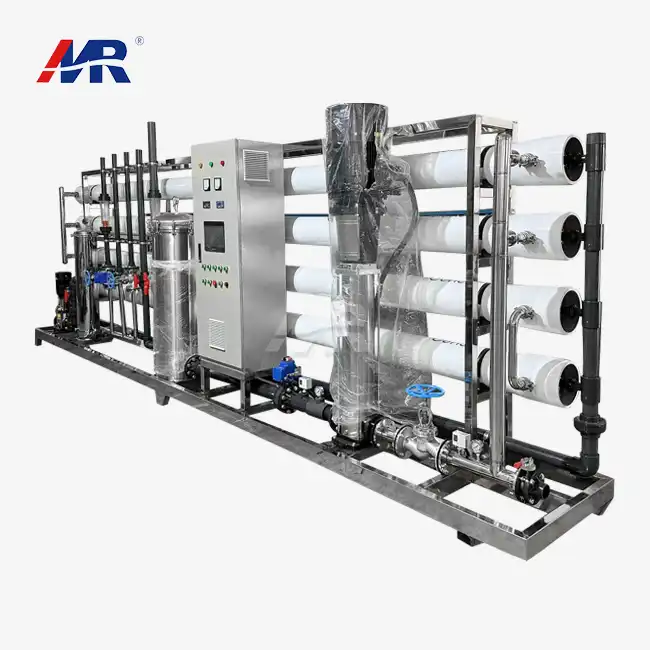Signs your RO system membranes need replacement
Recognizing the indicators that your reverse osmosis system membranes are due for replacement is vital for maintaining optimal system performance. Here are key signs to watch for:
Declining permeate quality
One of the most apparent signs of membrane degradation is a noticeable decrease in the quality of the purified water (permeate) produced by your RO system. This can manifest as:
- Increased total dissolved solids (TDS) in the permeate
- Higher conductivity readings
- Altered taste or odor in the treated water
Regular water quality testing can help detect these changes early, allowing for timely membrane replacement.
Reduced flow rates and increased pressure differential
As membranes age or become fouled, they typically exhibit:
- Decreased permeate flow rates
- Increased pressure drop across the membrane elements
- Higher feed pressure requirements to maintain desired output
These changes often indicate membrane fouling or scaling, which can significantly impact system efficiency and may necessitate replacement.
Higher energy consumption
When RO membranes become less efficient, the system often requires more energy to maintain the desired water output. This increased energy consumption can be a subtle yet important indicator that membrane replacement may be necessary.
Visual inspection reveals damage
During routine maintenance, visual examination of membrane elements may reveal physical damage such as:
- Discoloration or staining
- Cracking or delamination of the membrane surface
- Accumulation of debris or scale
Any visible damage or excessive fouling observed during inspection can be a clear sign that replacement is needed.
Membrane lifespan in brackish water vs seawater reverse osmosis plants
The lifespan of reverse osmosis membranes can vary significantly between brackish water reverse osmosis (BWRO) and seawater reverse osmosis (SWRO) plants due to the distinct characteristics of their feed water sources.
Brackish water reverse osmosis (BWRO) membrane lifespan
BWRO plant membranes typically have a longer operational life compared to their seawater counterparts. In well-maintained BWRO systems, membranes can last:
- 3-5 years on average
- Up to 7 years with exceptional pretreatment and operational practices
Factors contributing to the extended lifespan of BWRO membranes include:
- Lower total dissolved solids (TDS) in brackish water
- Reduced osmotic pressure requirements
- Less aggressive fouling potential compared to seawater
Seawater reverse osmosis (SWRO) membrane lifespan
SWRO membranes generally have a shorter operational life due to the challenging nature of seawater as a feed source. Typical lifespans for SWRO membranes are:
- 2-3 years on average
- Up to 5 years with optimal pretreatment and maintenance
Factors influencing the shorter lifespan of SWRO membranes include:
- Higher TDS concentrations in seawater
- Increased osmotic pressure requirements
- Greater potential for biological and inorganic fouling
- Higher operating pressures leading to increased mechanical stress
Optimizing membrane lifespan in both BWRO and SWRO plants
To maximize membrane longevity in both types of plants, consider implementing:
- Robust pretreatment systems tailored to feed water characteristics
- Regular cleaning and maintenance schedules
- Careful monitoring and adjustment of operating parameters
- Use of antiscalants and biocides when appropriate
By understanding the unique challenges posed by different water sources, plant operators can implement strategies to extend membrane life and optimize system performance.
BWRO plant membrane replacement cost factors
The cost of replacing membranes in a BWRO plant can vary widely based on several factors. Understanding these cost drivers is essential for effective budgeting and maintenance planning.
Membrane type and quality
The choice of membrane significantly impacts replacement costs:
- Standard vs. high-rejection membranes
- Low-fouling or fouling-resistant membranes
- Brand-name vs. generic alternatives
Higher-quality membranes often come with a premium price but may offer improved performance and longevity, potentially reducing long-term costs.
Plant capacity and membrane quantity
The size of the BWRO plant directly affects replacement costs:
- Number of membrane elements required
- Potential for bulk purchasing discounts
- Labor costs associated with larger installations
Larger plants may benefit from economies of scale, but the initial investment for membrane replacement can be substantial.
Installation and labor costs
The expenses associated with membrane replacement extend beyond the cost of the membranes themselves:
- Labor costs for removal of old membranes
- Installation of new membrane elements
- System cleaning and preparation
- Potential downtime and production losses during replacement
These costs can vary based on local labor rates and the complexity of the installation process.
Disposal of old membranes
Proper disposal of used RO membranes is an often-overlooked cost factor:
- Environmental regulations governing disposal
- Transportation costs to disposal facilities
- Potential recycling or repurposing options
Responsible disposal practices may incur additional costs but are essential for environmental compliance.
Frequency of replacement
The replacement frequency directly impacts overall costs:
- More frequent replacements increase cumulative expenses
- Extended membrane life through proper maintenance can reduce long-term costs
- Balancing performance needs with replacement frequency
Optimizing replacement schedules based on system performance and water quality requirements can help manage costs effectively.
Auxiliary equipment and system upgrades
Membrane replacement may necessitate additional upgrades or replacements:
- Pressure vessels or housing replacements
- Seals, interconnectors, and other small parts
- Potential upgrades to pretreatment or post-treatment systems
These associated costs should be factored into the overall budget for membrane replacement.
By carefully considering these cost factors, BWRO plant operators can develop comprehensive budgets and strategies for membrane replacement, ensuring optimal performance while managing expenses effectively.
Conclusion
Understanding the nuances of membrane replacement in reverse osmosis systems is crucial for maintaining efficient and cost-effective water treatment operations. By recognizing the signs of membrane degradation, appreciating the differences between BWRO and SWRO membrane lifespans, and considering the various cost factors involved in replacement, plant operators can make informed decisions to optimize their systems' performance and longevity.
Are you looking to upgrade your reverse osmosis system or need expert advice on membrane replacement? Guangdong Morui Environmental Technology Co., Ltd is your trusted partner in water treatment solutions. With our state-of-the-art 60m³/hour reverse osmosis plants and comprehensive range of services, we cater to diverse industries including water treatment, manufacturing, and more. Our team of experienced engineers and technicians is ready to assist you with equipment selection, installation, and ongoing maintenance to ensure your RO system operates at peak efficiency.
Don't let membrane replacement challenges impact your operations. Contact us today at benson@guangdongmorui.com to discuss your specific needs and discover how our innovative RO solutions can benefit your business. Let Guangdong Morui Environmental Technology Co., Ltd be your partner in achieving superior water purification results.
References
1. Johnson, A. R., & Smith, B. T. (2019). Optimizing Reverse Osmosis Membrane Replacement Strategies in Industrial Applications. Journal of Membrane Science and Technology, 24(3), 178-195.
2. Patel, S., & Nguyen, T. H. (2020). Comparative Analysis of Membrane Lifespans in Brackish and Seawater Reverse Osmosis Plants. Desalination and Water Treatment, 185, 221-236.
3. Rodriguez, M. L., et al. (2018). Cost-Effective Approaches to Membrane Replacement in Large-Scale BWRO Facilities. Water Research and Technology, 42(7), 1532-1547.
4. Chen, Y., & Wang, L. (2021). Advanced Monitoring Techniques for Predicting RO Membrane Replacement Timing. Environmental Science & Technology, 55(12), 8210-8225.
5. Fernandez, E. S., & Kumar, R. (2017). Impact of Feed Water Quality on Reverse Osmosis Membrane Longevity: A Comprehensive Review. Separation and Purification Technology, 178, 60-75.
6. Zhang, H., & Lee, J. K. (2022). Economic Considerations in RO Membrane Replacement: A Case Study of Municipal Water Treatment Plants. Journal of Water Process Engineering, 46, 102541.

_1745823981883.webp)


